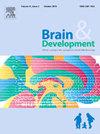Tryptophan metabolism in children with migraine: The role of kynurenine pathway
IF 1.3
4区 医学
Q4 CLINICAL NEUROLOGY
引用次数: 0
Abstract
Background
Migraine is a common neurological disorder in children, significantly impacting quality of life and academic performance. The kynurenine pathway, a major metabolic route of tryptophan, plays a critical role in neuroinflammation and neurotransmission, yet its involvement in pediatric migraine remains unexplored. This study aims to investigate alterations in kynurenine pathway metabolites in children with migraine and assess their correlation with headache frequency and severity.
Methods
A case-control study was conducted including pediatric patients diagnosed with migraine (n = 45) and healthy controls (n = 48). Serum levels of tryptophan (TRP) and its kynurenine pathway metabolites—including kynurenine (KYN), kynurenic acid (KYNA), 3-hydroxykynurenine (3−HK), and 3-hydroxyanthranilic acid (3-HANA)—were quantified using liquid chromatography-tandem mass spectrometry (LC-MS/MS). The Pediatric Migraine Disability Assessment (PedMIDAS) scores were used to evaluate the functional impact of migraine. Statistical analyses included comparisons between groups and correlation assessments between metabolite levels and clinical parameters.
Results
KYN, KYNA, and the KYN/TRP ratio were significantly higher in the migraine group compared to controls (p < 0.05). KYNA/3-HK ratios showed a negative correlation with headache frequency and PedMIDAS scores, whereas 3-HK levels were positively correlated with PedMIDAS scores. Receiver operating characteristic curve analysis identified KYN as a potential biomarker for distinguishing migraine patients from controls, with a sensitivity of 86.7 % and specificity of 45.8 % at a cutoff value of 1415.
Conclusion
This study is the first to evaluate kynurenine pathway metabolites in pediatric migraine. The findings suggest that alterations in the tryptophan-kynurenine pathway, particularly increased KYN and KYNA levels, may serve as compensatory mechanisms in migraine pathophysiology. Future studies should explore the therapeutic implications of targeting the kynurenine pathway in pediatric migraine treatment.
儿童偏头痛的色氨酸代谢:犬尿氨酸途径的作用
背景:偏头痛是一种常见的儿童神经系统疾病,严重影响儿童的生活质量和学习成绩。犬尿氨酸途径是色氨酸的主要代谢途径,在神经炎症和神经传递中起着关键作用,但其在儿童偏头痛中的作用仍未被探索。本研究旨在探讨儿童偏头痛患者犬尿氨酸途径代谢物的变化,并评估其与头痛频率和严重程度的相关性。方法采用病例对照研究,将诊断为偏头痛的儿童患者(n = 45)和健康对照组(n = 48)纳入研究。采用液相色谱-串联质谱(LC-MS/MS)定量测定血清色氨酸(TRP)及其犬尿氨酸途径代谢物——包括犬尿氨酸(KYN)、犬尿氨酸酸(KYNA)、3-羟基犬尿氨酸(3- HK)和3-羟基苯甲酸(3- hana)水平。儿童偏头痛残疾评估(PedMIDAS)评分用于评估偏头痛的功能影响。统计分析包括组间比较和代谢物水平与临床参数的相关性评估。结果偏头痛组的skyn、KYNA和KYN/TRP比值显著高于对照组(p <;0.05)。KYNA/3-HK比值与头痛频率和PedMIDAS评分呈负相关,而3-HK水平与PedMIDAS评分呈正相关。受试者工作特征曲线分析发现,KYN作为区分偏头痛患者和对照组的潜在生物标志物,灵敏度为86.7%,特异性为45.8%,临界值为1415。结论本研究首次对小儿偏头痛的犬尿氨酸途径代谢物进行了研究。研究结果表明,色氨酸-犬尿氨酸通路的改变,特别是KYN和KYNA水平的增加,可能是偏头痛病理生理的代偿机制。未来的研究应探讨针对犬尿氨酸途径在儿童偏头痛治疗中的治疗意义。
本文章由计算机程序翻译,如有差异,请以英文原文为准。
求助全文
约1分钟内获得全文
求助全文
来源期刊

Brain & Development
医学-临床神经学
CiteScore
3.60
自引率
0.00%
发文量
153
审稿时长
50 days
期刊介绍:
Brain and Development (ISSN 0387-7604) is the Official Journal of the Japanese Society of Child Neurology, and is aimed to promote clinical child neurology and developmental neuroscience.
The journal is devoted to publishing Review Articles, Full Length Original Papers, Case Reports and Letters to the Editor in the field of Child Neurology and related sciences. Proceedings of meetings, and professional announcements will be published at the Editor''s discretion. Letters concerning articles published in Brain and Development and other relevant issues are also welcome.
 求助内容:
求助内容: 应助结果提醒方式:
应助结果提醒方式:


